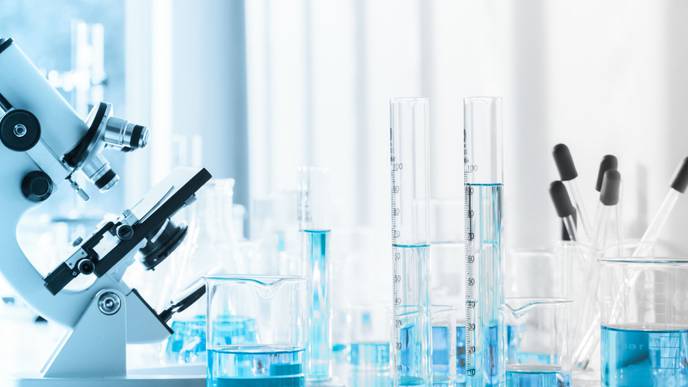Aerosolized ACE2 Neutralizes COVID-19 Variants in Lab and Mice Tests

10/01/2023
In a recent preprint posted to the bioRxiv* server, researchers from the University of Texas Southwestern, USA, developed an aerosolized and mutant form of angiotensin-converting enzyme 2 (ACE2) and tested its efficacy in neutralizing severe acute respiratory syndrome coronavirus 2 (SARS-CoV-2) in vitro and in vivo. They found that the modified ACE2 could effectively inhibit infections by viral variants in cultured cells and neutralize SARS-CoV-2 in mice models, suggesting its prophylactic potential against the coronavirus disease 2019 (COVID-19).
Study: Development of a mutant aerosolized ACE2 that neutralizes SARS-CoV-2 in vivo. Image Credit: TopMicrobialStock / Shutterstock
*Important notice: bioRxiv publishes preliminary scientific reports that are not peer-reviewed and, therefore, should not be regarded as conclusive, guide clinical practice/health-related behavior, or treated as established information.
Background
SARS-CoV-2 is a rapidly evolving virus. Variants of concern continue to emerge, several of which have been shown to be highly infectious, virulent, and even capable of evading the immune system. This emphasizes the need to develop potent therapeutic and prophylactic agents that protect against existing and emerging variants.
ACE2 is a cell-surface receptor that binds to SARS-CoV-2 and allows its entry into cells. A soluble, enzymatically inactive form of ACE2 is currently being explored by preclinical and clinical studies for its antiviral effects. However, there are no reports so far of a soluble ACE2 that can be easily purified and noninvasively administered while offering protection against COVID-19 in vivo. Researchers in the present study have addressed this gap by developing a recombinant ACE2 that was delivered as an aerosol and demonstrated protection against SARS-CoV-2 infection in mice models.
About the study
A space-filling mutation (T371W) was introduced in the active site of an endogenous soluble ACE2 (ACE2T371W). To check whether the antiviral properties of ACE2T371W were retained post-nebulization, gel electrophoresis was used to compare the filtration profiles of the candidate pre- and post-nebulization. Its receptor binding domain (RBD)-binding properties were assessed using isothermal titration calorimetry.
For in vitro studies, in the presence of the soluble ACE2T371W (sACE2T371W), Huh7.5 cells were transduced with lentivirus particles pseudo-typed with spike protein from several SARS-CoV-2 variants, namely G614, alpha, beta, gamma, delta, and omicron. As a control, lentivirus particles pseudo-typed with glycoprotein from vesicular stomatitis virus (VSV-G) were used.
To study the effect of the mutated ACE2 candidate in vivo, K18-hACE2 mouse models, highly sensitive to SARS-CoV-2 with 100% lethality, were used. The mice were nebulized with ACE2T371W either 30 minutes or four hours prior to infection with the gamma variant of SARS-CoV-2 at 1000 plaque-forming units (PFU). The weight and survival of the mice were monitored daily. Statistical significance was determined using unpaired t-tests and log-rank tests.
Results and discussion
The ACE2T371W protein was found to be enzymatically inactive while retaining its ability to bind to SARS-CoV-2, indicating its antiviral properties. The mutation facilitated simple and rapid purification of the protein via one-step affinity chromatography with a yield of up to 10 mg/L culture. The purified protein was found to be dimeric and thermally stable.
In vitro, sACE2T371W was found to inhibit spike-pseudo-typed lentiviruses between 65% and 95% in a dose-dependent manner. Although the inhibitory effect varied across SARS-CoV-2 variants, strong inhibition was observed against a clinical isolate of the delta variant and the Wu-1 strain. Additionally, the nebulized form of ACE2T371W was also found to inhibit SARS-CoV-2 in vitro.
In the in vivo studies, the test mice (treated with aerosolized ACET371W 30 minutes before infection) were found to lose weight at a significantly lower rate than the controls. While all the control mice succumbed to infection, only one death was observed in the test mice group on day 7. However, this effect could not be replicated when the mice were treated with aerosolized ACE2T371W about four hours prior to infection with SARS-CoV-2, suggesting that the prophylactic effect is more prominent when the viral exposure takes place soon after treatment with aerosolized ACE2T371W.
Additionally, in a separate cohort, no detectable viruses were found in the lungs of mice treated with aerosolized ACE2T371W as compared to 107 PFU per gram of tissue found in controls. When the mice were treated with aerosolized ACE2T371W 30 minutes post-infection, the researchers found that the treated mice showed lesser weight loss and improved survival compared to controls. Although this suggests the potential therapeutic effects of ACE2T371W, further research must be conducted to confirm these findings in a larger sample size.
Conclusion
The study provides proof-of-concept for the efficacy of ACE2T371W against SARS-CoV-2 variants both in vitro and in vivo. Given the efficiency of its large-scale purification and its convenient aerosolized delivery, ACE2T371W appears to be a promising candidate with prophylactic and therapeutic potential against infection by a wide range of SARS-CoV-2 variants. Further research is required to understand the clinical utility of ACE2T371W in preventing the spread of COVID-19.
*Important notice: bioRxiv publishes preliminary scientific reports that are not peer-reviewed and, therefore, should not be regarded as conclusive, guide clinical practice/health-related behavior, or treated as established information.

Facebook Comments